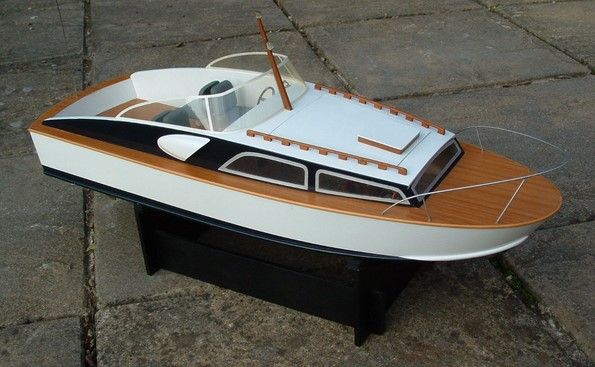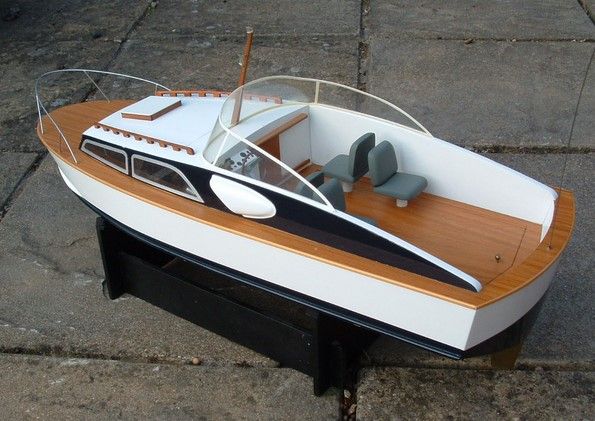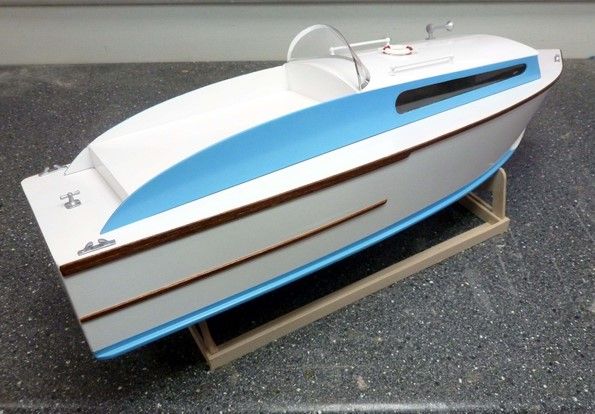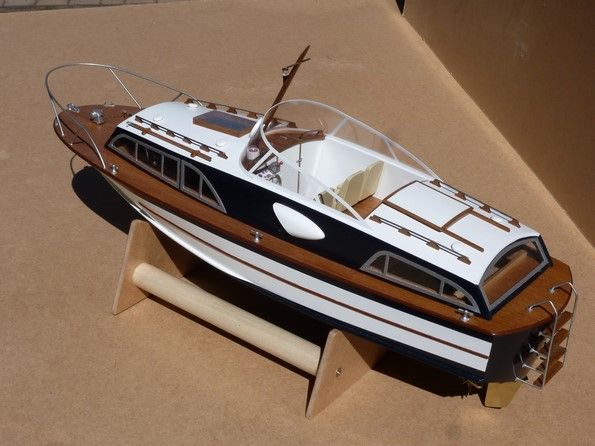Dave Milbourn tells us what works for him.

Fairey Swordsman
Three different methods of covering and finishing balsa and ply wood models
There is no agreed “best practice” here. This is just the way I did it – there are numerous variations on the same themes. Suit yourselves; it works for me.
Enjoy more Model Boats Magazine reading in the monthly magazine.
Click here to subscribe & save.
Tissue and sanding sealer
After final sanding with 180 and 320 Finishing Paper, give the whole model one coat of cellulose modelling sanding sealer*, thinned 50/50. Rub down with 320 grit Finishing Paper. Cover the hull sides, bottom panels and transom with lightweight aeromodelling tissue* as separate panels. Cut the tissue slightly over-sized then lay it onto the model and brush thinned sanding sealer through it. Immediately smooth down the tissue with a folded piece of kitchen roll, removing any wrinkles and mopping up excess sealer in the process. You may need to cut slits in the tissue to negotiate around compound curves, but you can sand away any areas of double-thickness tissue later on. Allow to dry, then feather off the edges with 320 paper. Apply a further three coats of thinned sealer, allowing to dry between coats. Rub down to a satin finish with 320 Finishing Paper. Don’t cover around inside corners as the sealer has a shrinking action and will result in voids under the tissue; cut the tissue hard up into such corners with a sharp blade instead.
Now apply two spray coats of Halfords Primer (or equivalent car paint); allow to dry for 24 hours, then rub down with 600 grit Wet or Dry* paper, used wet. Rinse off any paint dust; allow to dry naturally; dust off then apply three thin coats of gloss, leaving each coat to dry for at least 20 minutes before applying the next coat. Remove any masking tape as soon as this final coat is touch-dry, but leave it at least 24 hours before proceeding.
*Further notes:
Sanding Sealer is a mixture of clear cellulose dope and a filler powder. Humbrol is probably the best-known brand but I also have acquired assorted tins from H Marcel-Guest and J Perkins. If you can’t obtain any then you can make your own by adding talcum powder to clear dope. It should not be used “thick” – I thin down the commercial stuff 50/50 with ‘Standard Thinners,’ bought in volume from a local car paint supplier, and apply it with a flat, soft brush. A wide, flat squirrel-hair brush is best. I bought a set of three different widths from E-Bay for less than a fiver. Modelling tissue is available from most model shops under the name Modelspan and is commonly used to cover the open rib-and-spar structures of small model aircraft.
Wet or Dry Paper is available from practically any shop which sells car paints – Halfords being the most obvious. I use several grades from 600 to 1200 for finishing paintwork; the former for flatting down primer and the finer grades for later coats. Wetting the paper helps it “stick” to the paint and eases removal of the paint surface, while rubbing wetted 1000 or 1200 paper onto a block of ordinary soap will give a very fine abrasive suitable for flatting down final gloss coats prior to lacquering, burnishing or polishing.

Fairey Swordsman
Eze-Kote and glass-fibre cloth
You could just prime and paint the bare wood but this wouldn’t add anything to its strength. Balsa is not a very forgiving wood when it comes to rough handling; it “dings” easily if you clatter into anything remotely sharp, so I recommend using a lightweight fibreglass cloth and either Deluxe Materials’ Eze-Kote or Zap Epoxy Finishing Resin. I chose Eze-Kote for ‘Twinkler’ but only because I had some! There is an excellent demo of how to apply Eze-Kote and glass cloth on You Tube – here’s a summary:
Sand the model smooth with 240 grit Silicon Carbide paper and remove all dust. Apply one coat of Eze-Kote and allow to dry (30-40minutes). Re-sand using 320 grit paper, and remove dust.
Apply cloth in panels; one for each of the sides; one for each of the bottom panels; one for the transom and one for the deck. Cut the cloth about 2” larger all round than the panel and lay it onto the model without any creases or folds.
Brush Eze-Kote through the cloth, working from the centre outwards. Use a piece of stiff plastic like an old credit card to gently “squeegee” out any excess resin from the cloth and allow to dry for 20-30 minutes.
Using a sanding block, feather the edges gently to cut through the cloth and remove the excess. Apply another coat of Eze-Kote. When dry, sand with 400 grit paper.
The surface is now ready to be primed and painted.

Twinkler design by Vic Smeed built by Dave Milbourn
ZAP Finishing resin (epoxy) and glass-fibre cloth
If you have used liteply it’s a good idea to fill the grain. I’ve used Deluxe Materials’ Model Lite and also ordinary interior-grade vinyl-based spackle in the past (e.g. Fine Surface Polyfilla). Just apply it thinly with a plastic card or squeegee; allow to dry then sand back to the wood with 320 grit abrasive. Brush off all of the dust and then go over the whole model again with the dusting brush on the household vacuum-cleaner, just to be sure.
I use lightweight glass-fibre cloth and epoxy finishing resin for most of my wooden models. It’s a lot easier these days to obtain good-quality materials, which makes sanding the resin no longer the chore it used to be. I use the 1oz/m² cloth, which is one grade heavier than the very lightest available. Cut the cloth a few inches larger all round than the model; take care not to stretch the cloth or you’ll open up big gaps in the weave which will be difficult to fill. Apply a very light coat of 3M’s ‘Spraymount’ all over the surface to be covered – a light dusting allowed to settle from about a foot away is all that’s required to make the model slightly tacky to the touch. Now lay the cloth gently onto the model, starting along the keel and gently smoothing it out towards the edge. When you’re happy with this, mix up some Z-Poxy Finishing Resin, adding about 10% ethanol to thin it. This is also known as ‘rubbing alcohol’ and can be obtainable from various sources on the Internet. You could use methylated spirit but there is a small water content in this which will affect the setting time of the resin. Apply a coat of resin all over the cloth, again starting along the keel and brushing outwards. Take special care along the edges. You can use an old plastic bank-card to squeegee out any excess resin if you wish. Allow this to set thoroughly (about 3 hours at room temperature) then “feather” off the excess cloth around the edges with some 320 grit abrasive. Cover the transom in the same way. Apply another thin coat of resin all over the hull, leave it to set and then rub down the finished hull.
The inside of the hull must be waterproofed to prevent the joints from coming apart etc. I use a couple of coats of finishing resin, thinned down as before. There’s no need to be fussy here – just slosh it around until everything is thoroughly soaked then leave it to set.
For a finish I generally use Halfords High-Fill primer/filler, followed by Halfords primer and top coat. If you stick to one type of paint then there is no risk of incompatible types ruining your finish. Halfords also make clear varnish to suit their aerosol spray paints; this is available in both gloss and satin.

Fairey Huntsman 31
General notes for all methods
Finishing paper (which is also sometimes called Production Paper) is a pale grey colour. It’s manufactured from silicon carbide and can be obtained on the Internet e.g. from Toolbank. I use a selection of 180, 240, 320 and 400 for finishing wooden models. Other manufacturers may offer different grades.
When sanding a timber hull smooth prior to painting, ALWAYS wrap the paper around a flat block – never use a fold of paper in the hand (you’ll just dig grooves in the surface where your fingers are). Sand with a circular motion and let the paper do the work; don’t press on too hard. Once the paper clogs, replace it.
Don’t just rely on a good blow to remove dust; use a clean paint-brush on uncoated wood to brush away the dust, then go over the whole thing with the domestic vacuum cleaner, using that little round dusting brush attachment. Wash down the sanded primer and gloss coats with clean water and allow to dry naturally.
Never spray in a cold or damp atmosphere; aim for a minimum 15 degrees C. Any colder and you risk the paint crazing at a later stage; ask me how I know…..
Always wear a proper face-mask when spraying (Machine Mart do an excellent one with replaceable filters for about £15).
THE TWO BIGGEST ENEMIES OF A DECENT PAINT-JOB ARE DUST AND IMPATIENCE.




